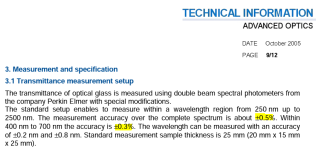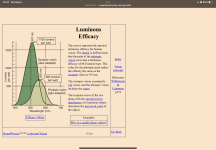It’s somewhere between 0.88 and 0.90, the other numbers are fluff.
That's an interval of 88%-90%
89.3 +- 1 = consistently measured as being between 88.3 and 90.3
That's an interval of 88.3%-90.3%
Nothing you said changes what I said.
irregardless of how you think of the precision of measurements: rounding can lead to different results, so yes, my comment changes what you said.
Here is an example:
Suppose the true transmission is 89.5%, there can be a difference in the outcome whether or not you take the "fluff" numbers into account:
If you have 30 measurements with reading of 0.1% and deviation (precision) of 1% (random numbers 89.5 +-1% in excel), you can get the following:
90,0 89,8 89,9 90,1 89,5 89,6 89,6 90,1 90,4 89,9 90,5 89,6 90,0 89,9 89,8 89,2 88,8 89,3 89,0 89,3 88,9 89,0 89,4 88,6 88,8 89,3 89,0 89,5 88,6 88,9
You average 89,5% +-1%, but as the outcome is 89,47%, rounding would actually result in 89%.
take note that the average is designed into the numbers (random deviations of +-1% hoovering around 89.5%), so the larger the dataset, the closer it gets to the average, and in this example, it's pretty close.
If you have the exact same 30 measurements (same random numbers 89.5 +-1% in excel) and you think the decimals are fluff because you consider every decimal to have no relevant information, and thus you round those 30 measurements, you get:
90 90 90 90 90 90 90 90 90 90 91 90 90 90 90 89 89 89 89 89 89 89 89 89 89 89 89 90 89 89
You average 89.6%+-1%, or, if rounded to the closest digit, 90%+-1%
So if you
1. take the measurements with decimals for granted (as you trust the precision of the measurement), but round the average to the closest digit, you get 89%. That is 0.5% off the true value, by leaving out info (measurements with decimals) you trust.
2. don't take the decimals in the measurements for granted (you don't trust the precision), and round the measurements themselves to the closest digit, you get 89.6% (0.1% off the true value and the value you would have gotten when including decimals), but as you are keen on rounding the decimals out, your end result is 90%. That's also 0.5% off the true value, and 1% off the first approach.
Note that you will probably get closer to the true value if you're rounding, but only if you do a lot more measurements than if you would just include the decimals, or omit the rounding of averages.
If those results are important or relevant, is up to you, or maybe to a marketeer that would love to write '90% transmission' or 'highest transmission in its class'...








